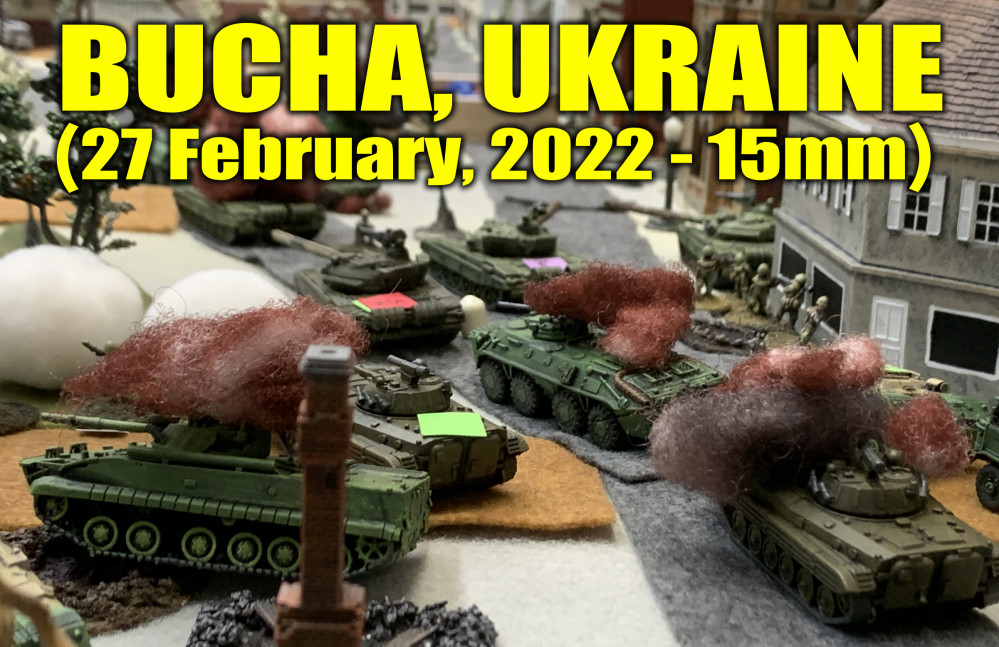
Bucha, Ukraine - 27 Feb 2022 - 15mm
Omaha Mega Game - Half Complete
Turn Ten is now complete, putting us at two hours after H-Hour on Omaha Beach.
The game is now half over.
Waves Four and Five are now ashore. The last German heavy artillery has been silenced (10.5cm, 15.0cm, and nebelwerfer batteries), and engineers have started clearing not only blocks across the four vital exit draws off of Omaha Beach, lanes through the beach shingle, and paths through German minefields, but also gaps in the beach obstacles at the water’s edge. The tide is coming in, after all, and American waves Six, Seven, Eight, and Nine are still due. In game terms, any American unit trying to land in a hex marked “OPEN” (after a successful engineer check) does NOT have to make the “landing survival roll” that has been killing or dispersing so many American units just trying to enter the game.
But two blocks remain across the crucial draws. The Americans only hold three of the eleven objective markers. And five German “wiederstandnester” fortified strongpoints remain intact, garrisoned, and offering brutal resistance on the bluffs and across that blood-soaked sand.
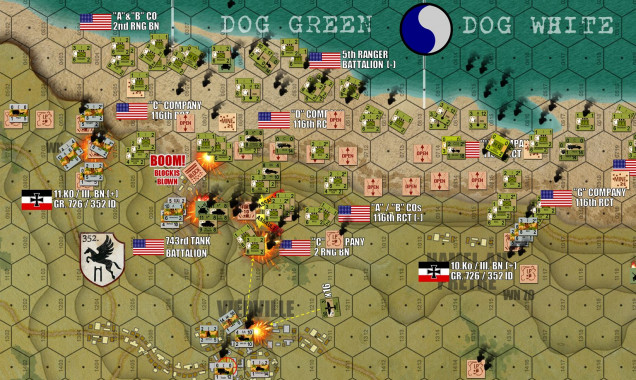 Turn 07 – Wiederstandnester 71, the historical bunker that we’ve all seen dispense so much carnage in Saving Private Ryan, is finally stormed by none other than “C” Company, 2nd Ranger Battalion, the historical unit into which “Captain Miller” and the other characters were written. They even had engineers with them (reflecting the flamethrowers used in the final assault on the bunker). Some of the Rangers and their engineers, however, have actually been destroyed by German 2.0cm flak firing from Vierville, in turn destroyed by P-47s making strafing runs. Ironically, this is NOT how it happened historically. The Rangers never made it up the bluff until this bunker and draw were cleared by other units from the east. So they had to endure up to five hours of what we see in the movie, and never “won” in the end, facts which I often cite to show that the Dog Green landings were provably MUCH MUCH worse than even than epic scene tries to show. Historically, Wiederstandnester 70 and 69 fell first, and Brigadier General Cota (XO, 29th Infantry Division) led a big hook from the east through Hamel au Petre and the outskirts of Vierville to clear that draw from the east in mid-afternoon. But as we saw earlier, in this game BGen Cota has actually not made it ashore (Robert Mitchum in The Longest Day), instead sunk against German beach obstacles in an earlier turn. Meanwhile OTHER engineers (146th Engineer Combat Team) have blown the block across the DOG ONE draw. This exit off Dog Green is ALMOST open!
Turn 07 – Wiederstandnester 71, the historical bunker that we’ve all seen dispense so much carnage in Saving Private Ryan, is finally stormed by none other than “C” Company, 2nd Ranger Battalion, the historical unit into which “Captain Miller” and the other characters were written. They even had engineers with them (reflecting the flamethrowers used in the final assault on the bunker). Some of the Rangers and their engineers, however, have actually been destroyed by German 2.0cm flak firing from Vierville, in turn destroyed by P-47s making strafing runs. Ironically, this is NOT how it happened historically. The Rangers never made it up the bluff until this bunker and draw were cleared by other units from the east. So they had to endure up to five hours of what we see in the movie, and never “won” in the end, facts which I often cite to show that the Dog Green landings were provably MUCH MUCH worse than even than epic scene tries to show. Historically, Wiederstandnester 70 and 69 fell first, and Brigadier General Cota (XO, 29th Infantry Division) led a big hook from the east through Hamel au Petre and the outskirts of Vierville to clear that draw from the east in mid-afternoon. But as we saw earlier, in this game BGen Cota has actually not made it ashore (Robert Mitchum in The Longest Day), instead sunk against German beach obstacles in an earlier turn. Meanwhile OTHER engineers (146th Engineer Combat Team) have blown the block across the DOG ONE draw. This exit off Dog Green is ALMOST open! 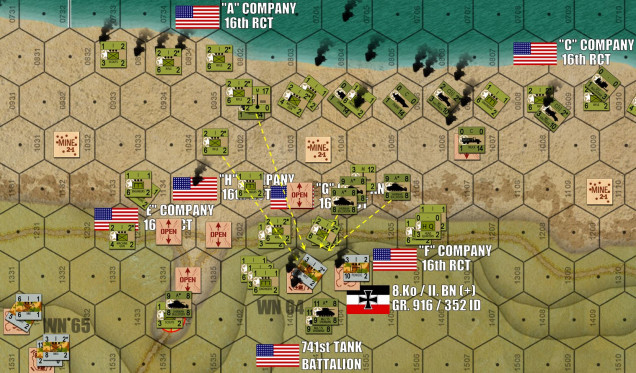 How strong are these Germanbunkers? Well here we have 27 Shermans, a BATTERY of heavy 4.2 inch mortars, another battery of 81mm battalion mortars, and the bulk of 2nd Battalion / 16th Regimental Combat Team / 1st Infantry Division wailing on WN64 overlooking the EASY ONE draw … and still 8. Kompanie / II Bn / 916. Grenadier Regiment is holding out.
How strong are these Germanbunkers? Well here we have 27 Shermans, a BATTERY of heavy 4.2 inch mortars, another battery of 81mm battalion mortars, and the bulk of 2nd Battalion / 16th Regimental Combat Team / 1st Infantry Division wailing on WN64 overlooking the EASY ONE draw … and still 8. Kompanie / II Bn / 916. Grenadier Regiment is holding out. 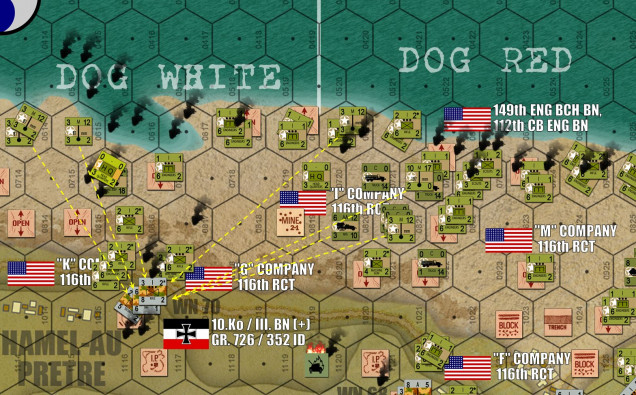 Into Turn 8, the Germans are also ferociously holding out at WN70 at Hamel-au-Pretre. Here we see more 4.2-inch “chemical” mortars (the “10-M-17” mortar battery at upper right). This is “D” Battery / 81st Chemical Mortar Battalion, so named because the 107mm mortars were originally intended to lay smoke and also white phosphorus shells, officially considered “chemical” ordinance by the US Army at the time.
Into Turn 8, the Germans are also ferociously holding out at WN70 at Hamel-au-Pretre. Here we see more 4.2-inch “chemical” mortars (the “10-M-17” mortar battery at upper right). This is “D” Battery / 81st Chemical Mortar Battalion, so named because the 107mm mortars were originally intended to lay smoke and also white phosphorus shells, officially considered “chemical” ordinance by the US Army at the time. 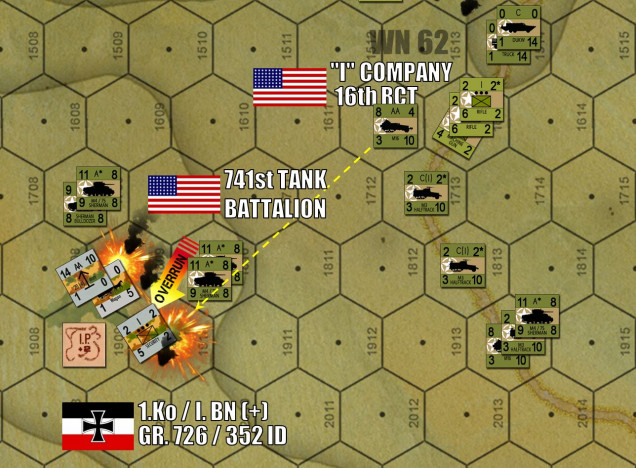 On the east flank, things are going better for the Americans. EASY THREE was the first draw to be opened, and Shermans are now two kilometres inland and beginning to take out German support positions. Two of these counters (each is a platoon of five, so ten tanks in all) rolled up on this German FlaK battery, withstood German fire, and then blasted it to smithereens. The platoon of garrison troops with the FlaK tried to run, but were pinned down by the quad .50 caliber fire coming off that M16 halftrack to the northeast during opportunity fire. These pinned troops were then overrun by two other Sherman platoons. Bute the “DUKW” amphibious trucks, American vehicles landed in the later stages of D-Day.
On the east flank, things are going better for the Americans. EASY THREE was the first draw to be opened, and Shermans are now two kilometres inland and beginning to take out German support positions. Two of these counters (each is a platoon of five, so ten tanks in all) rolled up on this German FlaK battery, withstood German fire, and then blasted it to smithereens. The platoon of garrison troops with the FlaK tried to run, but were pinned down by the quad .50 caliber fire coming off that M16 halftrack to the northeast during opportunity fire. These pinned troops were then overrun by two other Sherman platoons. Bute the “DUKW” amphibious trucks, American vehicles landed in the later stages of D-Day. Into Turn 9, Shermans are not doing so well here in west, where the objective hex behind that blown block is held by German halftracks and “Panzerschreck” equipped infantry (panzerschreck was basically a German copy of the American “Bazooka”) of 14. Kompanie / 916. GR / 352nd Infanterie Division. One halftrack platoon was already destroyed before this turn (equipped with light 3.7cm AT guns). Now another SdKfz 251 platoon is destroyed. But meanwhile, these panzerschreck infantry, assisted by 7.5cm AT fire from the other shoulder of the draw at WN72, have wrecked two five-tank platoons of Shermans. Meanwhile, the Rangers have pushed inland, and have kicked off a battle in the town of Vierville itself. One platoon is pinned down by an SdKfz 10/5 halftrack with 2.0cm autocannon. That’s understandable. But another platoon of RANGERS is pinned down by lucky opportunity fire from that BICYCLE SECTION? Okay, lucky roll, but I’ve said it before. German bicycle troops are MIGHTY!
Into Turn 9, Shermans are not doing so well here in west, where the objective hex behind that blown block is held by German halftracks and “Panzerschreck” equipped infantry (panzerschreck was basically a German copy of the American “Bazooka”) of 14. Kompanie / 916. GR / 352nd Infanterie Division. One halftrack platoon was already destroyed before this turn (equipped with light 3.7cm AT guns). Now another SdKfz 251 platoon is destroyed. But meanwhile, these panzerschreck infantry, assisted by 7.5cm AT fire from the other shoulder of the draw at WN72, have wrecked two five-tank platoons of Shermans. Meanwhile, the Rangers have pushed inland, and have kicked off a battle in the town of Vierville itself. One platoon is pinned down by an SdKfz 10/5 halftrack with 2.0cm autocannon. That’s understandable. But another platoon of RANGERS is pinned down by lucky opportunity fire from that BICYCLE SECTION? Okay, lucky roll, but I’ve said it before. German bicycle troops are MIGHTY! 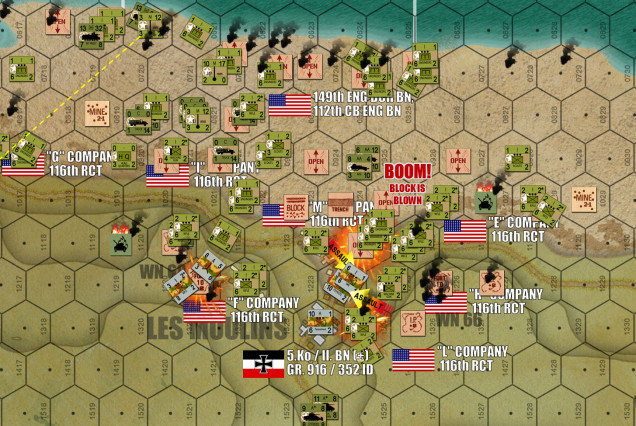 Still on Turn 9, the last block is blown at DOG THREE. Meanwhile, bloodied and exhausted survivors of 2nd Battalion (How, Easy, Fox Companies) and 3rd Battalion (Mike and Love Companies) of 116th Regimental Combat Team then assault the German company dug into the abandoned French buildings at Les Moulins immediately behind the block.
Still on Turn 9, the last block is blown at DOG THREE. Meanwhile, bloodied and exhausted survivors of 2nd Battalion (How, Easy, Fox Companies) and 3rd Battalion (Mike and Love Companies) of 116th Regimental Combat Team then assault the German company dug into the abandoned French buildings at Les Moulins immediately behind the block. 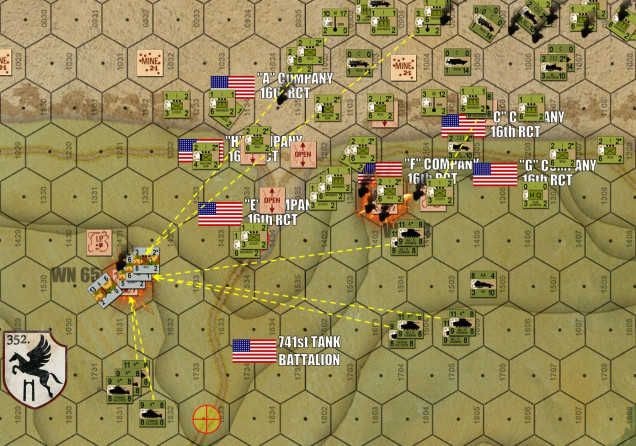 Turn 10 starts out with a frustrating American barrage positively POURING fire into WN 65 at the EASY ONE Draw. At least the 7.5cm PaK 40s have been taken out, so the American tanks of 741st Tank battalion can come closer in relative safety. Meanwhile, Fox Company / 2nd Bn / 16th RCT has taken WN 64, along with plenty of engineers support (bangalore torpedoes, flamethrowers, and satchel charges).
Turn 10 starts out with a frustrating American barrage positively POURING fire into WN 65 at the EASY ONE Draw. At least the 7.5cm PaK 40s have been taken out, so the American tanks of 741st Tank battalion can come closer in relative safety. Meanwhile, Fox Company / 2nd Bn / 16th RCT has taken WN 64, along with plenty of engineers support (bangalore torpedoes, flamethrowers, and satchel charges).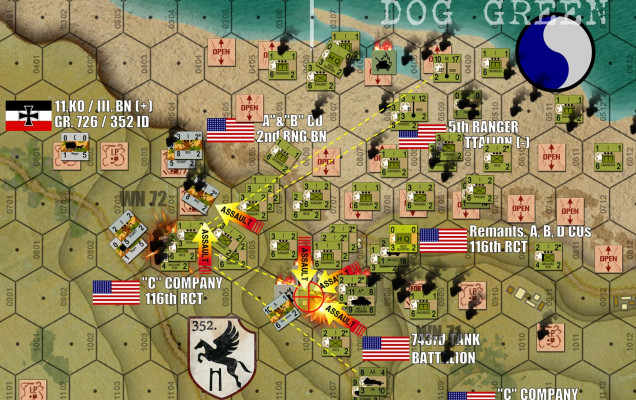 Turn 10 … and the Americans are done playing around. The beachbuildings overlooking the DOG ONE draw are assaulted by 80 Rangers, 160 riflemen of 29th Infantry, and 40 engineers, attacking from four directions. At last the Germans are crushed in this hex, clearing the beach exit behind the concrete block previously blown. Meanwhile, another 240 American infantry assault part of WN 72. This assault will be tougher, as the American approach is limited by steep, impassable cliffs rising off of Charlie Beach to the north. But the assault is precipitated by a heavy barrage of battalion mortars, 4.2-inch chemical mortars, tanks, and two types of AA halftracks. Meanwhile, note that successive waves of engineers have been rolling to place more and more “OPEN” counters on beachside landing hexes. This is going to drastically reduce the losses incurred amongst successive waves landing on the beachhead.
Turn 10 … and the Americans are done playing around. The beachbuildings overlooking the DOG ONE draw are assaulted by 80 Rangers, 160 riflemen of 29th Infantry, and 40 engineers, attacking from four directions. At last the Germans are crushed in this hex, clearing the beach exit behind the concrete block previously blown. Meanwhile, another 240 American infantry assault part of WN 72. This assault will be tougher, as the American approach is limited by steep, impassable cliffs rising off of Charlie Beach to the north. But the assault is precipitated by a heavy barrage of battalion mortars, 4.2-inch chemical mortars, tanks, and two types of AA halftracks. Meanwhile, note that successive waves of engineers have been rolling to place more and more “OPEN” counters on beachside landing hexes. This is going to drastically reduce the losses incurred amongst successive waves landing on the beachhead.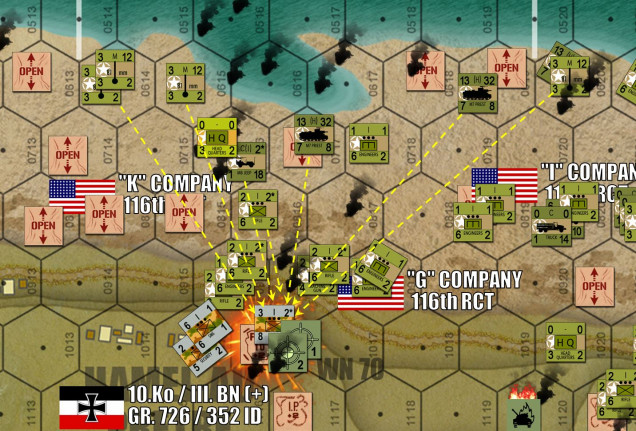 At last the Hamel-au-Pretre bunker starts to crack, only after two batteries of M-7 “Priest” 105mm self-propelled howitzers land and open fire point-blank over open sights sight into the bluff. That’s 12 guns, plus four BATTERIES of 81mm mortars (24 tubes in all), plus the direct rifle and machine gun fire of six platoons of rifles and engineers and scouts (call it 240 men in all). Even the regimental commander’s jeeps join in with their .50cals (bright green HQ unit). These RCT command teams landed in multiple phases … so let’s say Brigadier General Cota found another LCI to put him ashore after his first was damaged or sunk. Robert Mitchum is back in the battle!
At last the Hamel-au-Pretre bunker starts to crack, only after two batteries of M-7 “Priest” 105mm self-propelled howitzers land and open fire point-blank over open sights sight into the bluff. That’s 12 guns, plus four BATTERIES of 81mm mortars (24 tubes in all), plus the direct rifle and machine gun fire of six platoons of rifles and engineers and scouts (call it 240 men in all). Even the regimental commander’s jeeps join in with their .50cals (bright green HQ unit). These RCT command teams landed in multiple phases … so let’s say Brigadier General Cota found another LCI to put him ashore after his first was damaged or sunk. Robert Mitchum is back in the battle! 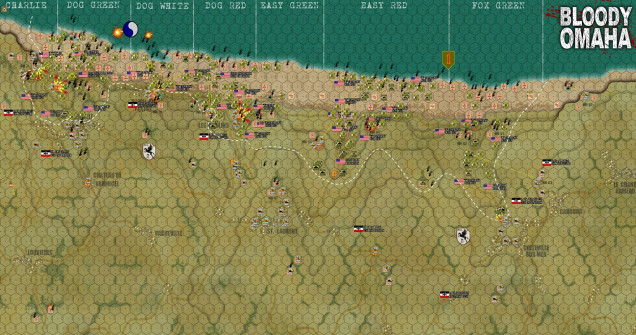 The overall situation at the end of Turn 10. The white line shows the extent of American penetration so far. As you can see, the game is pretty serious in its historical detail, but player agency and the luck of the dice ARE throwing a few curve balls in here, this beachhead is NOT shaped exactly like the historical result. While success was much heavier in the east than the west, the thick bulge in the extreme west north of Vierville should not be there. Instead, better penetration was effected just to the east of that, near Hamel-au-Pretre. Pretty much reverse the results of Dog Green and Dog White and you have a pretty close to historical result. SO FAR, American casualties are actually a little worse than they were historically, we’re running about 120 units “eliminated” in game terms, delivering an approximate 4200 casualties, with about 1,050 of those killed. Then again, we’re making progress faster than American made historically, especially in the bloody west. The Germans, meanwhile, have lost about 40 units. While their number of killed will thus be naturally lower, ALL survivors (wounded or not) in eliminated platoons are considered POWs. In total German losses are looking like about 2,000, with 320 of these killed and the rest wounded, taken prisoner, or both.
The overall situation at the end of Turn 10. The white line shows the extent of American penetration so far. As you can see, the game is pretty serious in its historical detail, but player agency and the luck of the dice ARE throwing a few curve balls in here, this beachhead is NOT shaped exactly like the historical result. While success was much heavier in the east than the west, the thick bulge in the extreme west north of Vierville should not be there. Instead, better penetration was effected just to the east of that, near Hamel-au-Pretre. Pretty much reverse the results of Dog Green and Dog White and you have a pretty close to historical result. SO FAR, American casualties are actually a little worse than they were historically, we’re running about 120 units “eliminated” in game terms, delivering an approximate 4200 casualties, with about 1,050 of those killed. Then again, we’re making progress faster than American made historically, especially in the bloody west. The Germans, meanwhile, have lost about 40 units. While their number of killed will thus be naturally lower, ALL survivors (wounded or not) in eliminated platoons are considered POWs. In total German losses are looking like about 2,000, with 320 of these killed and the rest wounded, taken prisoner, or both. 




























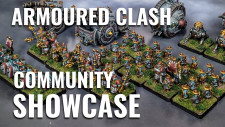












































Love the AAR! Thanks Jim! Question: I don’t remember the HQ’s from the game, and wondered if they had a function… morale? Movement?
Also, is this whole thing too early for 21st Panzer to make an appearance, or are they still waiting to counterpunch at Calais?
Glad you liked it, @cpauls1 and thanks for the great questions. Answer: PanzerBlitz SORT OF had HQ units in the form of the old “CP” units (command posts). They really served no game purpose other than some scenarios had them set up in fortifications as objectives or the like. Panzer Leader did away with them more or less entirely, and Arab-Israeli Wars never brought them back. I use them in Panzer Leader and Arab Israeli Wars … basically as “window dressing.” In small games, Battalion HQs have a small effect, in medium games = Regimental HQs, and in big games,… Read more »
I love watching this play out.
Watching the results come in day after day but knowing that only a couple of hours have transpired lets the gravity of the actions sink in each day.
Thanks @templar007 – Finished Turn 11 last night and started Turn 12 … Towed American artillery (limbered to DUKW amphibious trucks) is starting to come ashore … thank God those Navy Beach battalions have cleared at least 50% of the landing beaches for German obstacles (so I don’t have to keep making those rolls). Lost one battery of 75mms, though … And further inland the Germans are putting up a startlingly TOUGH fight in Colleville-sur-Mer.